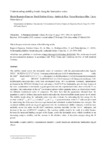Mostrar o rexistro simple do ítem
Understanding stability trends along the lanthanide series
| dc.contributor.author | Regueiro-Figueroa, Martín | |
| dc.contributor.author | Esteban-Gómez, David | |
| dc.contributor.author | Blas, Andrés de | |
| dc.contributor.author | Rodríguez-Blas, Teresa | |
| dc.contributor.author | Platas-Iglesias, Carlos | |
| dc.date.accessioned | 2018-11-27T09:27:45Z | |
| dc.date.available | 2018-11-27T09:27:45Z | |
| dc.date.issued | 2014-04-01 | |
| dc.identifier.citation | Regueiro‐Figueroa, Esteban‐Gómez, D., de Blas, A., Rodríguez‐Blas, T. and Platas‐Iglesias, C. (2014), Understanding Stability Trends along the Lanthanide Series. Chem. Eur. J., 20: 3974–3981. | es_ES |
| dc.identifier.issn | 0947-6539 | |
| dc.identifier.issn | 1521-3765 | |
| dc.identifier.uri | http://hdl.handle.net/2183/21361 | |
| dc.description.abstract | [Abstract] The stability trends across the lanthanide series of complexes with the polyaminocarboxylate ligands TETA4− (H4TETA=2,2′,2′′,2′′′‐(1,4,8,11 tetraazacyclotetradecane‐1,4,8,11‐tetrayl)tetraacetic acid), BCAED4− (H4BCAED=2,2′,2′′,2′′′ {[(1,4‐diazepane‐1,4‐diyl)bis(ethane‐2,1‐diyl)]bis(azanetriyl)}tetraacetic acid), and BP18C62− (H2BP18C6=6,6′‐[(1,4,10,13‐tetraoxa‐7,16‐diazacyclooctadecane‐7,16 diyl)bis(methylene)]dipicolinic acid) were investigated using DFT calculations. Geometry optimizations performed at the TPSSh/6‐31G(d,p) level, and using a 46+4fn ECP for lanthanides, provide bond lengths of the metal coordination environments in good agreement with the experimental values observed in the X‐ray structures. The contractions of the Ln3+ coordination spheres follow quadratic trends, as observed previously for different isostructural series of complexes. We show here that the parameters obtained from the quantitative analysis of these data can be used to rationalize the observed stability trends across the 4f period. The stability trends along the lanthanide series were also evaluated by calculating the free energy for the reaction [La(L)]n+/−(sol)+Ln3+(sol)→[Ln(L)]n+/ (sol)+La3+(sol). A parameterization of the Ln3+ radii was performed by minimizing the differences between experimental and calculated standard hydration free energies. The calculated stability trends are in good agreement with the experimental stability constants, which increase markedly across the series for BCAED4−complexes, increase smoothly for the TETA4− analogues, and decrease in the case of BP18C62− complexes. The resulting stability trend is the result of a subtle balance between the increased binding energies of the ligand across the lanthanide series, which contribute to an increasing complex stability, and the increase in the absolute values of hydration energies along the 4f period. | es_ES |
| dc.description.sponsorship | Xunta de Galicia; CN2012/011 | es_ES |
| dc.language.iso | eng | es_ES |
| dc.publisher | Wiley | es_ES |
| dc.relation.uri | https://doi.org/10.1002/chem.201304469 | es_ES |
| dc.rights | This is the peer reviewed version of the following article: Regueiro‐Figueroa, Esteban‐Gómez, D., de Blas, A., Rodríguez‐Blas, T. and Platas‐Iglesias, C. (2014), Understanding Stability Trends along the Lanthanide Series. Chem. Eur. J., 20: 3974–3981, which has been published in final form at https://doi.org/10.1002/chem.201304469. This article may be used for non-commercial purposes in accordance with Wiley Terms and Conditions for Use of Self-Archived Versions. | es_ES |
| dc.subject | Complex stability | es_ES |
| dc.subject | Computational chemistry | es_ES |
| dc.subject | Density functional calculations | es_ES |
| dc.subject | Lanthanides | es_ES |
| dc.subject | Ligand effects | es_ES |
| dc.title | Understanding stability trends along the lanthanide series | es_ES |
| dc.type | info:eu-repo/semantics/article | es_ES |
| dc.rights.access | info:eu-repo/semantics/openAccess | es_ES |
| UDC.journalTitle | Chemistry - A European Journal | es_ES |
| UDC.volume | 20 | es_ES |
| UDC.issue | 14 | es_ES |
| UDC.startPage | 3974 | es_ES |
| UDC.endPage | 3981 | es_ES |
Ficheiros no ítem
Este ítem aparece na(s) seguinte(s) colección(s)
-
GI-REACT! - Artigos [113]






